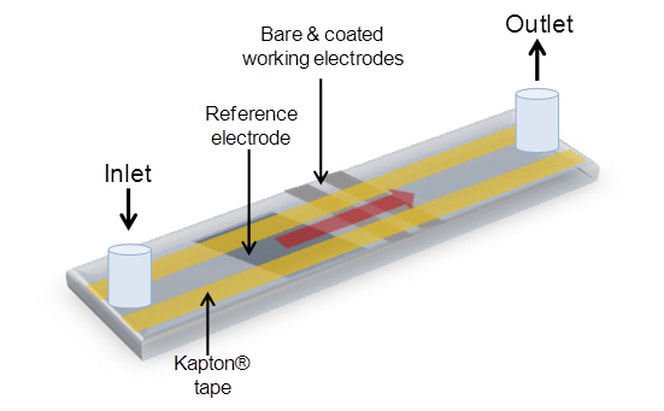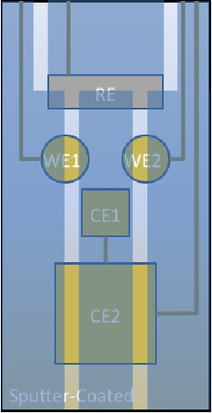Gas Sensors for Biological Applications
Our work in this area focuses on the development of sensors for the detection and monitoring of gaseous molecules of biological significance, including nitric oxide, carbon monoxide, and hydrogen sulfide. These small molecules are produced endogenously and are implicated in many essential physiological processes. Sensors fabricated in our lab have taken the form of microelectrodes, dual-sensing electrodes, interdigitated arrays, and microfluidic devices. In an effort to optimize these sensors for clinical and/or biological utility, analytical merits—such as sensitivity to the target analyte, selectivity over interferents, stability of performance, and ease of assembly/use—are thoroughly characterized. Overall, our research lies at the intersection of electrochemistry and materials science with applications in biology.

We are developing electrochemical sensors that measure NO directly and S-nitrosothiols, the endogenous carrier molecules of NO. Unlike most other technologies (e.g., fluorescence, chemiluminescence) which measure stable NO byproducts or require reaction with dyes, our approach enables us to measure NO directly and in real-time. Research in our lab is focused on developing permselective electrode membranes which permit NO diffusion to the electrode surface and exclude other electroactive interferents, including nitrite and ascorbate. Carrying this technology forward, we are particularly interested in measuring NO in complex environments such as blood and wound fluid. With such applications, we aim to study NO's roles in wound healing and the immune response, which have been poorly understood due to an inability to measure NO.
Hydrogen sulfide (H2S) is one of the new endogenously produced, gaseous signaling molecules that we are interested in measuring. Hydrogen sulfide, along with nitric oxide and carbon monoxide, belongs to a family of signaling molecules known as gasotransmitters. Abandoning the pre-existing notion that hydrogen sulfide was only a toxic gas, the scientific community began to recognize its important biological functions only recently. At sub-millmolar levels, H2S plays an integral role in the neurological, cardiovascular, gastrointestinal, and endocrine systems. Unfortunately, the inability to measure biological H2S accurately and in real-time remains a limiting step in understanding its physiological significance. Our goal is to develop an electrochemical sensor that is capable of direct and selective H2S measurement. Such a measurement platform will help to further our understanding of the roles that H2S plays in cellular function and pinpoint its exact biological concentrations.


